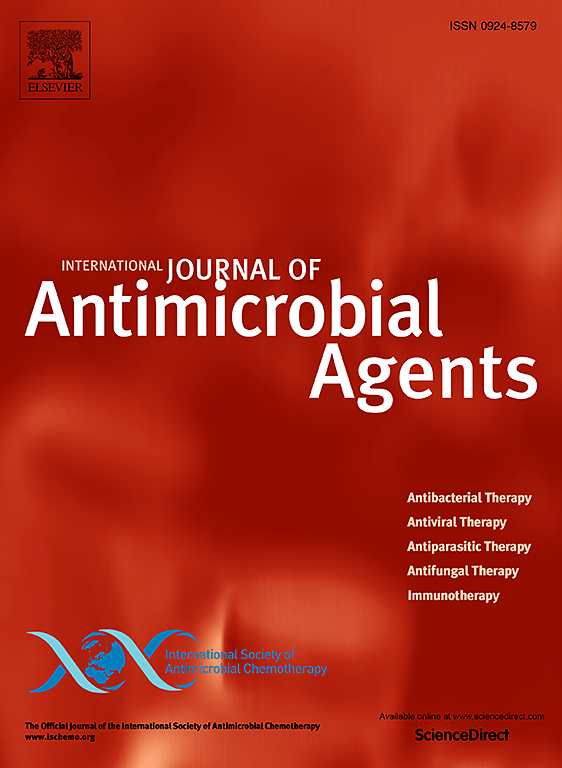Characterization of a Novel KPC-2 Variant, KPC-228, Conferring Resistance to Ceftazidime–Avibactam in an ST11-KL64 Hypervirulent Klebsiella pneumoniae
IF 4.6
2区 医学
Q1 INFECTIOUS DISEASES
International Journal of Antimicrobial Agents
Pub Date : 2024-12-19
DOI:10.1016/j.ijantimicag.2024.107411
引用次数: 0
Abstract
Background
With the widespread clinical use of ceftazidime–avibactam (CZA), reports of resistance have increased continuously, posing immense threats to public health worldwide. In this study, we explored the underlying mechanisms leading to the development of CZA resistance in an ST11-KL64 hypervirulent Klebsiella pneumoniae CRE146 that harbored the blaKPC-228 gene.
Methods
Twelve carbapenem-resistant Klebsiella pneumoniae (CRKP) strains were isolated from the same patient, including K. pneumoniae CRE146. Whole-genome sequencing (WGS), phylogenetic analysis, blaKPC gene cloning and pACYC-KPC construction assays were conducted to further explore the molecular mechanisms of CZA resistance. Quantitative siderophore production assay, string test, capsule quantification and Galleria mellonella in vivo infection model were applied to verify the level of pathogenicity of K. pneumoniae CRE146.
Results
This strain carried key virulence factors, iutA-iucABCD operon and rmpA gene. Compared to the wild-type KPC-2 carbapenemase, the novel KPC-228 enzyme exhibited a deletion of four amino acids in the Ω-loop (del_167-170_ELNS). In addition, the emergence of CZA resistance appeared to be associated with drug exposure, and we observed the in vivo evolution of wild-type KPC-2 to KPC-228 and then the reversion to its original wild-type KPC-2. The blaKPC-228 gene was located within the double IS26 flanking the ISKpn6-blaKPC-228-ISKpn27 core structure and carried on an IncFII/IncR-type plasmid. Notably, CRE146 exhibited high-level resistance to CZA (64/4 mg/L) but increased susceptibility to meropenem (1 mg/L) and imipenem (0.5 mg/L) respectively. PACYC-KPC plasmids were constructed and expressed in K. pneumoniae ATCC13883. Compared to K. pneumoniae ATCC13883 harboring blaKPC-2, K. pneumoniae ATCC13883 harboring blaKPC-228 exhibited a high-level resistance to CZA (32/4 mg/L) and increased susceptibility to meropenem (1 mg/L) and imipenem (0.5 mg/L). Interestingly, K. pneumoniae ATCC13883 harboring blaKPC-228 showed a significant decrease in their resistance to all β-lactamases tested except CZA and ceftazidime.
Conclusions
In conclusion, we reported a novel KPC variant, KPC-228, in a clinical ST11-KL64 hypervirulent K. pneumoniae strain, which conferred CZA resistance, possibly through enhancing ceftazidime affinity and reducing avibactam binding. The blaKPC-228 can mutate back to blaKPC-2 under carbapenem pressure, which was very detrimental to clinical treatment. This strain carried both resistance and virulence genes, posing a major challenge in clinical management.
ST11-KL64高致病性肺炎克雷伯菌中一种新的KPC-2变体KPC-228的特征,赋予其对头孢他啶-阿维巴坦的耐药性。
随着头孢他啶-阿维巴坦(CZA)的广泛临床应用,耐药性报告不断增加,对全球公共卫生构成巨大威胁。在这项研究中,我们探索了携带blaKPC-228基因的ST11-KL64高毒肺炎克雷伯菌CRE146产生CZA耐药的潜在机制。从同一例患者中分离出12株耐碳青霉烯类肺炎克雷伯菌(CRKP),包括克雷伯菌CRE146。通过全基因组测序(WGS)、系统发育分析、blaKPC基因克隆和pACYC-KPC构建分析等方法,进一步探索CZA抗性的分子机制。采用定量产铁载体法、串珠试验、胶囊定量法和体内感染模型验证肺炎克雷伯菌CRE146的致病性水平。该菌株携带关键毒力因子、iutA-iucABCD操纵子和rmpA基因。与野生型KPC-2碳青霉烯酶相比,新型KPC-228酶在Ω-loop (del_167-170_ELNS)中缺失了4个氨基酸。此外,CZA耐药的出现似乎与药物暴露有关,我们观察了野生型KPC-2在体内进化到KPC-228,然后恢复到原始野生型KPC-2。blaKPC-228基因位于ISKpn6-blaKPC-228-ISKpn27核心结构两侧的双IS26中,并携带在IncFII/ incr型质粒上。值得注意的是,CRE146对CZA表现出较高的抗性(64/4 mg/L),但对美罗培南(1 mg/L)和亚胺培南(0.5 mg/L)的敏感性分别增加。构建PACYC-KPC质粒,并在肺炎克雷伯菌ATCC13883中表达。与携带blaKPC-2的肺炎克雷伯菌ATCC13883相比,携带blaKPC-228的肺炎克雷伯菌ATCC13883对CZA具有较高的耐药性(32/4 mg/L),对美罗培南(1 mg/L)和亚胺培南(0.5 mg/L)的敏感性增加。有趣的是,携带blaKPC-228的肺炎克雷伯菌ATCC13883对除CZA和头孢他啶外的所有β-内酰胺酶的耐药性均显著降低。总之,我们在临床ST11-KL64高毒性肺炎克雷伯菌株中报道了一种新的KPC变体KPC-228,该变体可能通过增强头孢他啶亲和力和减少阿维巴坦结合而赋予CZA抗性。在碳青霉烯压力下,blaKPC-228可以突变回blaKPC-2,这对临床治疗非常不利。该菌株携带耐药和毒力基因,对临床管理提出了重大挑战。
本文章由计算机程序翻译,如有差异,请以英文原文为准。
求助全文
约1分钟内获得全文
求助全文
来源期刊
CiteScore
21.60
自引率
0.90%
发文量
176
审稿时长
36 days
期刊介绍:
The International Journal of Antimicrobial Agents is a peer-reviewed publication offering comprehensive and current reference information on the physical, pharmacological, in vitro, and clinical properties of individual antimicrobial agents, covering antiviral, antiparasitic, antibacterial, and antifungal agents. The journal not only communicates new trends and developments through authoritative review articles but also addresses the critical issue of antimicrobial resistance, both in hospital and community settings. Published content includes solicited reviews by leading experts and high-quality original research papers in the specified fields.

 求助内容:
求助内容: 应助结果提醒方式:
应助结果提醒方式:


